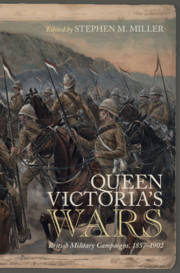Book contents
- Queen Victoria’s Wars
- Queen Victoria’s Wars
- Copyright page
- Contents
- Maps
- Contributors
- Acknowledgements
- 1 Introduction
- 2 The Indian Rebellion, 1857–1858
- 3 Punitive Expeditions in China, 1857–1860
- 4 The Expedition to Abyssinia, 1867–1868
- 5 The New Zealand Wars, 1845–1872
- 6 The Third Anglo-Asante War, 1873–1874
- 7 The Second Afghan War, 1878–1880
- 8 The Anglo-Zulu War, 1879
- 9 The First Anglo-Boer War, 1880–1881
- 10 Egypt and the Sudan, 1881–1885
- 11 The Third Anglo-Burmese War and the Pacification of Burma, 1885–1895
- 12 The Tirah Campaign, 1897–1898
- 13 Reconquest of the Sudan, 1896–1898
- 14 The South African War, 1899–1902
- 15 Conclusion
- Index
- References
8 - The Anglo-Zulu War, 1879
Published online by Cambridge University Press: 01 June 2021
- Queen Victoria’s Wars
- Queen Victoria’s Wars
- Copyright page
- Contents
- Maps
- Contributors
- Acknowledgements
- 1 Introduction
- 2 The Indian Rebellion, 1857–1858
- 3 Punitive Expeditions in China, 1857–1860
- 4 The Expedition to Abyssinia, 1867–1868
- 5 The New Zealand Wars, 1845–1872
- 6 The Third Anglo-Asante War, 1873–1874
- 7 The Second Afghan War, 1878–1880
- 8 The Anglo-Zulu War, 1879
- 9 The First Anglo-Boer War, 1880–1881
- 10 Egypt and the Sudan, 1881–1885
- 11 The Third Anglo-Burmese War and the Pacification of Burma, 1885–1895
- 12 The Tirah Campaign, 1897–1898
- 13 Reconquest of the Sudan, 1896–1898
- 14 The South African War, 1899–1902
- 15 Conclusion
- Index
- References
Summary
In 1877, the Transvaal was annexed by the British with the purpose of bringing confederation to South Africa. Influenced by Theophilus Shepstone, the Secretary for Native Affairs, Sir Henry Bartle Frere, the British Governor, came to believe that the Zulus posed the most obvious threat to the safe implementation of Confederation. Even before the ultimatum expired, British troops began to cross into territory claimed by the Zulu. Lord Chelmsford, the British commander, led the center column which reached the foot of a distinctive rocky outcrop known as iSandlwana on 20 January. A combination of faulty intelligence and his determination to engage the main force of the Zulu army before it could retreat led to Chelmsford’s decision to split his own force. Two days later, British forces left to guard the camp were overwhelmed by a spirited and experienced Zulu force. Chelmsford was forced to withdraw to safety. In March, having received reinforcements and eager to recover the initiative, Chelmsford renewed his offensive. Despite some setbacks, victories followed at Khambula and on 4 July, Cetshwayo’s royal homestead at oNdini (Ulundi), was raised to the ground. The victory was total.
Keywords
- Type
- Chapter
- Information
- Queen Victoria's WarsBritish Military Campaigns, 1857–1902, pp. 146 - 166Publisher: Cambridge University PressPrint publication year: 2021

